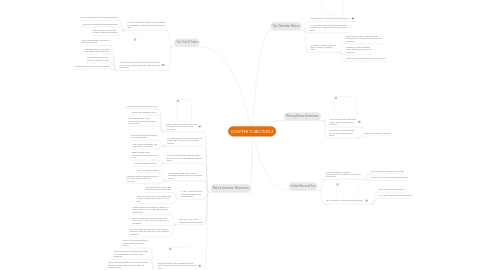
1. The Trail of Tears
1.1. In 1835, the Federal Government persuaded the Cherokee to sign a treaty giving up the land
1.1.1. Most Cherokee refused to honor the treaty
1.1.2. They wrote a protest to the government
1.1.3. Their plea did not persuade Jackson or the white settlers
1.2. In 1838, General Winfield Scott and an army of 7000 came to remove the Cherokee and move them west
1.2.1. Scott threatened to use force if they did not leave
1.2.2. The leaders gave in, knowing that fighting would be futile
1.2.3. The long march became known as the trail of tears
1.2.4. Thousands died from the brutal weather
2. Native American Resistance
2.1. Black Hawk led a force of Sauk and Fox people back to Illinois, their homeland
2.1.1. They wanted to recapture the land
2.1.2. Illinois responded with force
2.1.3. They chased them to the Mississippi river and slaughtered most of them
2.2. The Seminole from Florida were the only people who successfully resisted the removal
2.2.1. The Seminole chief refused to give up their lands
2.2.2. The Seminole decided to go against the US instead
2.3. The Seminole allied themselves with a group of African Americans who had run away
2.3.1. They attacked white settlements along the Florida coast
2.3.2. They used guerrilla tactics
2.4. In December 1835, the Seminole ambushed soldiers under Major Francis Dade
2.4.1. Only 110 soldiers survied
2.4.2. The Dade massacre pressured to call for more troops to fight the Seminole
2.5. In 1842, more than 1500 soldiers had died in the Seminole wars
2.5.1. The government gave up and allowed the Seminole to stay
2.5.2. Many Seminole however had either died or been captured and forced to move west
2.6. After 1842, only a few scattered groups remained
2.6.1. Native Americans had given up about 100 million acres of land in the east to federal government
2.6.2. They received about 68 millions dollars in return and 32 million acres in lands west of Mississippi
2.6.3. Eventually the reservations that they lived in would be faced with intrusion from the white civilization
2.7. The area present-day Oklahoma became part of the US with the Louisiana Purchase in 1803
2.7.1. The US set this area aside for various Native American groups
2.7.2. The Five Civilized Tribes were relocated in the eastern half of present-day Oklahoma
2.7.3. The US got agreements from the Plain groups that lived there to get along with the Five Civilized Tribes
2.7.4. The Five Tribes developed their homes in this area
3. Moving Native Americans
3.1. Five Civlizied Tribes; Cherokee, Creek, Seminole, Chicksaw, Choctaw
3.2. Area west of Mississippi was dry so few Americans lived there
3.2.1. Area was not good for farming
4. Indian Removal Act
4.1. This act allowed the Federal government to pay Native Americans to move west
4.1.1. Most Indians felt compelled to accept
4.1.2. Jackson sent officials to negotiate treaties
4.2. 1834 Congress created the Indian Territory
4.2.1. Area in present day Oklahoma
4.2.2. For Native Americans from Southeast
5. The Cherokee Nation
5.1. Cherokee nation refused to give up their land
5.2. In 1790's the government recognized the Cherokee as a separate nation but Georgia didnt
5.3. The nation sued the state and took the case to supreme court
5.3.1. Chief Justice John Marshall said that Georgia had no right to interfere with the Cherokee
5.3.2. President Jackson however, supported the removal of the Cherokee
5.3.3. Jackson said he would ignore the court ruling
